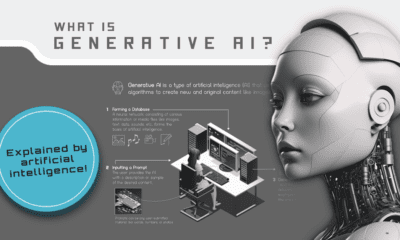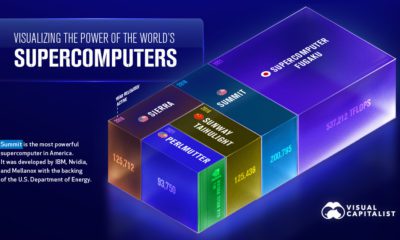Before the invention of the telephone, we had to be in the same room to communicate in real-time – and prior to the internet, we had to be in the same building to share our designs, new ideas, or other documents. Collaboration has always been a moving target, and in modern times we shouldn’t be surprised that new technological innovations are again shifting how humans work and coordinate together.
The New Collaboration Cycle
Today’s infographic comes to us from Schneider Electric, and it shows that humans are no longer making things using a linear approach. Instead, modern collaboration is a cyclical process with no defined start or end points – and it often involves more users and stakeholders, continuous access, and an increasingly decentralized workforce.
The 24/7 Knowledge Factory
All around the world, the way that teams work together is changing. Instead of always being centralized at a local level, teams are adding talent from around the world who bring diverse perspectives and new ideas to the table. The modern organization never sleeps – it has people from different countries, time zones, and cultures all working together to create new designs or products simultaneously. Collaboration on projects is happening in real-time, at all times of the day, and this has several benefits. It brings together a broader range of skills and perspectives, makes teams more customer-centric, reduces errors and wasted money, and enhances both decision-making and product development cycles.
Working Together is Changing
How are teams collaborating 24/7 in real-time from locations around the world? VR/AR Designers, engineers, and other team members can collaborate in parallel, using mixed reality as a common medium. Collaborative Intelligence (AI) Multi-agent, distributed systems where each agent, human or machine, is uniquely positioned, with autonomy to contribute to a problem-solving network. Advanced Modelling (3D and 4D printing) Design and manufacturing can be integrated seamlessly, even to customize individual items. 4d printing (fourth dimension: movement) is a new frontier where printed objects adapt to various circumstances. Crowd-based Collaboration Design is no longer siloed and can be democratized between different stakeholders. Further, teams can work simultaneously from all over the world. Computer Supported Collaborative Design (CSCD) The synchronous sharing of information and interaction with ideas, in an AI-driven, data-intensive environment. Here, problem solving, data and service “agents” support, or replace, labor intensive work and possibly the human traits of intuition and decisi, as well.n making.
The Next Wave
How humans work together is changing, but also shifting is how humans and AI will collaborate together. The new technological landscape creates many questions and uncertainties for companies today:
Will new “collaborative” technologies really change how we engage, and innovate with, our colleagues? Will a hyper-networked, always-engaged global collaborative environment create “too many cooks in the kitchen”? With more opportunity to get involved in processes, how does the role of the end-customer change? Will traditional design and implementation switch to being more service-based, as time goes on?
on But fast forward to the end of last week, and SVB was shuttered by regulators after a panic-induced bank run. So, how exactly did this happen? We dig in below.
Road to a Bank Run
SVB and its customers generally thrived during the low interest rate era, but as rates rose, SVB found itself more exposed to risk than a typical bank. Even so, at the end of 2022, the bank’s balance sheet showed no cause for alarm.
As well, the bank was viewed positively in a number of places. Most Wall Street analyst ratings were overwhelmingly positive on the bank’s stock, and Forbes had just added the bank to its Financial All-Stars list. Outward signs of trouble emerged on Wednesday, March 8th, when SVB surprised investors with news that the bank needed to raise more than $2 billion to shore up its balance sheet. The reaction from prominent venture capitalists was not positive, with Coatue Management, Union Square Ventures, and Peter Thiel’s Founders Fund moving to limit exposure to the 40-year-old bank. The influence of these firms is believed to have added fuel to the fire, and a bank run ensued. Also influencing decision making was the fact that SVB had the highest percentage of uninsured domestic deposits of all big banks. These totaled nearly $152 billion, or about 97% of all deposits. By the end of the day, customers had tried to withdraw $42 billion in deposits.
What Triggered the SVB Collapse?
While the collapse of SVB took place over the course of 44 hours, its roots trace back to the early pandemic years. In 2021, U.S. venture capital-backed companies raised a record $330 billion—double the amount seen in 2020. At the time, interest rates were at rock-bottom levels to help buoy the economy. Matt Levine sums up the situation well: “When interest rates are low everywhere, a dollar in 20 years is about as good as a dollar today, so a startup whose business model is “we will lose money for a decade building artificial intelligence, and then rake in lots of money in the far future” sounds pretty good. When interest rates are higher, a dollar today is better than a dollar tomorrow, so investors want cash flows. When interest rates were low for a long time, and suddenly become high, all the money that was rushing to your customers is suddenly cut off.” Source: Pitchbook Why is this important? During this time, SVB received billions of dollars from these venture-backed clients. In one year alone, their deposits increased 100%. They took these funds and invested them in longer-term bonds. As a result, this created a dangerous trap as the company expected rates would remain low. During this time, SVB invested in bonds at the top of the market. As interest rates rose higher and bond prices declined, SVB started taking major losses on their long-term bond holdings.
Losses Fueling a Liquidity Crunch
When SVB reported its fourth quarter results in early 2023, Moody’s Investor Service, a credit rating agency took notice. In early March, it said that SVB was at high risk for a downgrade due to its significant unrealized losses. In response, SVB looked to sell $2 billion of its investments at a loss to help boost liquidity for its struggling balance sheet. Soon, more hedge funds and venture investors realized SVB could be on thin ice. Depositors withdrew funds in droves, spurring a liquidity squeeze and prompting California regulators and the FDIC to step in and shut down the bank.
What Happens Now?
While much of SVB’s activity was focused on the tech sector, the bank’s shocking collapse has rattled a financial sector that is already on edge.
The four biggest U.S. banks lost a combined $52 billion the day before the SVB collapse. On Friday, other banking stocks saw double-digit drops, including Signature Bank (-23%), First Republic (-15%), and Silvergate Capital (-11%).
Source: Morningstar Direct. *Represents March 9 data, trading halted on March 10.
When the dust settles, it’s hard to predict the ripple effects that will emerge from this dramatic event. For investors, the Secretary of the Treasury Janet Yellen announced confidence in the banking system remaining resilient, noting that regulators have the proper tools in response to the issue.
But others have seen trouble brewing as far back as 2020 (or earlier) when commercial banking assets were skyrocketing and banks were buying bonds when rates were low.













